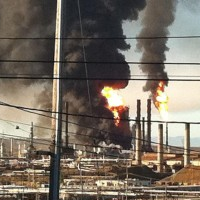Richmond City Council Rejects Planners, OKs Chevron Refinery Project
 Chevron refinery fire in Richmond (photo: Toni Hanna)
Chevron refinery fire in Richmond (photo: Toni Hanna)
Two years after a disastrous fire at Richmond’s Chevron oil refinery in the Bay Area amped up community opposition to the polluter in their midst, the city council voted to let the company move forward with a $1-billion renovation.
The 5-0 vote, with the mayor and vice mayor abstaining, rejected the recommendation of its city planning commission that Chevron put in more pollution controls, replace its piping and contribute a quarter billion dollars to local green projects through 2050. The commission also wanted Chevron to reduce all toxic air contaminants, put domes on its storage tanks and upgrade its tug boats.
The planning commission proposal had support from key environmental groups, although they felt it didn’t address many of their concerns.
As might be expected, people living near an oil refinery have health concerns and they had them before the 2012 fire sent 15,000 people to hospitals with breathing problems. The fire started after a badly corroded pipe leaked.
Most everyone agreed that the project is better for the community than one embarked upon earlier by Chevron, which was halted in mid-construction by a judge in 2008. That one was deemed to have insufficient air emissions analysis and mitigation and other flaws in its Environmental Impact Report (EIR).
Chevron wants to replace a 50-year-old hydrogen plant at the 100-year-old facility with technology that would give it the ability to refine dirtier oil with higher-sulfur content. The deal caps greenhouse gas emissions by limiting how much high-sulfur oil can be processed.
Chevron denies that it will be will bring in oil from the tar sands of Alberta, Canada, or fracked oil from North Dakota’s booming Bakken fields. Tar sands are the dirtiest fossil fuel on the planet and Bakken crude is plenty filthy. Both would have the added disadvantage of arriving by rail, an ever-more-popular and dangerous prospect as fracking operations expand in the West.
The agreement codifies that pledge, for now. Chevron would have to apply for additional permits to receive oil by rail.
Chevron’s assurance that its project is environmentally neutral relies to some extent on its buying carbon credits in the state’s cap-and-trade program, giving money to the city’s greenhouse gas reduction programs and making other onsite environmental improvements.
To make the deal more palatable, Chevron pledged to invest $9 million a year for 10 years in the community, which surrounds the plant. Chevron sweetened the pot with an extra $3 million a year at the last minute.
Not everyone found that acceptable. “When that money is gone, the refinery will still be here for decades,” the San Francisco Chronicle quoted one woman who addressed the council Tuesday night. “Don't give our kids backpacks and ice cream and then give them asthma and cancer.”
Chevron said it will go back to court to ask that the 2008 judgment against it be lifted. It was unclear whether environmental groups would sue over the council's decision.
–Ken Broder
To Learn More:
Richmond Approves Massive Chevron Refinery Project with $90 Million in Community Benefits (by Robert Rogers, Contra Costa Times)
Chevron Refinery Project Approved by Richmond City Council (by John Coté and David R. Baker, San Francisco Chronicle)
Chevron Gains City Approval for $1 Billion Refinery Project (by Lynn Doan, Bloomberg)
Lawsuit Calls Out Air Board over Permit for Chevron Refinery Expansion in Richmond (by Ken Broder, AllGov California)
- Top Stories
- Controversies
- Where is the Money Going?
- California and the Nation
- Appointments and Resignations
- Unusual News
- Latest News
- California Forbids U.S. Immigration Agents from Pretending to be Police
- California Lawmakers Urged to Strip “Self-Dealing” Tax Board of Its Duties
- Big Oil’s Grip on California
- Santa Cruz Police See Homeland Security Betrayal in Use of Gang Roundup as Cover for Immigration Raid
- Oil Companies Face Deadline to Stop Polluting California Groundwater





